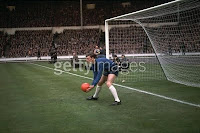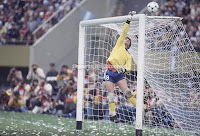When England
plays Brazil in the Maracana on 2 June it will be nearly 29 years to the day since
their last game in the old stadium. That game in 1984, a routine end of season
friendly will always be remembered for John Barnes ‘Brazilian’ goal, when he slalomed
through the Brazilian defence to score an incredible solo goal.
But how, at a
distance of nearly 30 years can one instantly identify this goal was scored at
the Maracana rather than Wembley? Or, given the Selecao’s Harlem
Globetrotters-style schedule, at the Maracana and not New York or Doha?
The answer is
simple. The goal nets.
Until recently
each region of the football world employed different methods of suspending the
goal nets. In England and the Low Countries, full support stanchions or “A-frames”
were favoured. In Central Europe triangular “elbows” or “Continental D”
supports were preferred. South America and Brazil’s on-field architecture of
choice was the “L-supports” seen at the 1950 World Cup final in the Maracana,
in the Argentina1978 World Cup finals and at the Maracana in 1984 when John
Barnes scored.
At club level
too, each ground could be individually identified by it’s goal nets. Chelsea
had a crook in the base of their stanchions, as did Barcelona whose goals were
easily identifiable from the curvy stanchions at the Bernabeu (the particular on-field
architecture of which Heart of Midlothian copied and made their own in
Scotland).
In this period,
right up to the 1980’s, clubs were brands and they celebrated their
individuality and highlighted their differences from other clubs, as brands do.
However clubs are no longer brands. Instead, the competitions the clubs play in
are the brands. So be it the Champions League or Premier League, the game’s
organisers sell a collective product with a homogenous design of on-field
architecture – the free-hanging box net.
Though the box
net has been around for over 100 years, it came to global prominence at the
1974 World Cup finals, the first tournament where a uniform method of
suspending the goal nets was employed across all stadia. In England, Europa 96
and UEFA’s insistence on uniform box nets spelt the end for individual goals at
the domestic club level.
Box nets are now
everywhere, including at the Maracana. On 2 June Wayne Rooney could dribble
past five Brazilian defenders and round the goalkeeper to score and, watching
on TV you wouldn’t know if he’d scored in Brazil or in Blackburn. Goal nets
everywhere look the same.
Check out the
message boards; fans everywhere mourn the loss of the different methods for
suspending the goal nets and their clubs and national sides’ subsequent loss of
individual identity.
Next year’s
World Cup finals in Brazil offers the opportunity to restore individual
identity in the game.
In the 1920’s
South American football began to differentiate itself from its Anglo-Saxon
equivalent by promoting the individual over collective values and musical
metaphors were employed to describe playmakers as conductors and wingers as
soloists. Football was recognised as
art. This reached its apogee in the 1970 World Cup final, where Brazil’s
virtuoso individuality and agility swept aside the organisation, physical force
and collective endeavour of Italy. “You
cannot be the best in the world at a game without loving it,” Hugh McIvanney
wrote in rapture at the final. No team has ever loved the game more, before or
since and the Selecao became synonymous with individuality in football.
The goal nets at
international tournaments have long influenced the club scene after the event.
Hence you’ll see Manchester United free-hanging their nets Spanish-style in
front of their existing stanchions after the 1982 World Cup, and Manchester
City installing the Continental D’s of Belgrade after Panenka and the European
Championships of 1976.
Thus, should FIFA
install Brazilian-style L-supports to suspend the goal nets at next year’s
Brazilian World Cup finals, it will not only delight fans the world over but be
a huge signal to the game’s national associations and competition organisers
that there is still space for individuality in this era of collectivism and
homogeneity.
Sign our petition at change.org and demand that FIFA World Cup 2014 respects the
traditions of the South American football region in general and Brazil in
particular, and promote regional and national identity in the game by adopting
the L-supports method of goal net suspension at each of the stadia at the World
Cup finals in Brazil.








